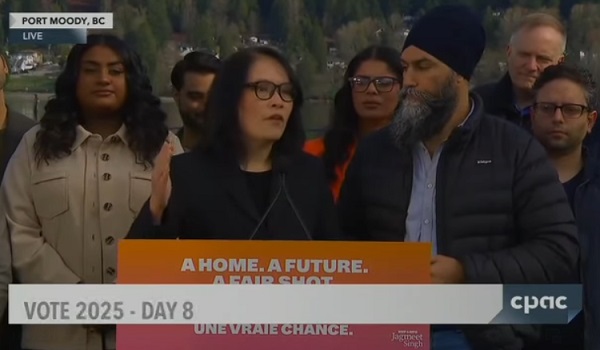Alberta
Alberta’s vision for passenger rail

Alberta’s government will develop a Passenger Rail Master Plan as the foundation to advancing passenger rail in the province.
Since the early days of Alberta’s development, the province has been shaped by the iron rails that crisscross its landscape. The arrival of the transcontinental railway in the late 19th century brought about profound changes to the way of life, facilitating trade, settlement, and economic prosperity. Towns and cities sprung up along the tracks, serving as vital hubs for commerce and transportation.
Today, the legacy of rail continues to shape Alberta and the rest of Canada. While the modes of transportation may have evolved, the spirit of innovation and connectivity remains as strong as ever. As Alberta experiences record population growth and evolving transportation needs, advancing passenger rail infrastructure is essential for enhancing accessibility, efficiency, and connectivity across the province.
Alberta’s Passenger Rail Master Plan will look forward decades and identify concrete actions that can be taken now as well as in the future to build the optimal passenger rail system for the province. The Master Plan will assess the feasibility of passenger rail in the province, including regional (inter-city), commuter and high-speed services.
“A large and efficient passenger rail network stretching across the province has incredible potential. It represents a forward-looking vision and is a mobility solution for our rapidly growing province and I’m excited to watch this plan take shape and bring us into the future. There’s a lot of work ahead of us, but I’m confident that we will build the network Albertans need to improve daily life and work, boost the economy and take away the stress of long-distance travel.”
“Alberta already has significant public mass transit systems in Calgary and Edmonton for the provincial passenger rail system to build upon. The Master Plan will be a vital tool to guide the province on the next steps in advancing passenger rail. It will provide certainty to the rail sector and ensure the most effective use of tax dollars and government authorities. We look forward to hearing from Albertans and working with municipalities, Indigenous communities and the private sector in advancing passenger rail in the province.”
Passenger rail services connected to urban mass transit shapes and strengthens regional transportation systems, connects communities, supports jobs and the economy and improves access to housing.
“Canada’s railways appreciate the Alberta government’s efforts to conduct a fact-based study on the potential for passenger rail service that recognizes the essential need to protect current and future freight rail capacity. Any proposal to co-locate passenger service in freight corridors must demonstrate the ability to preserve the freight rail capacity required to move goods in support of the province’s economy, today and tomorrow. Rail is the greenest mode of ground transportation for both people and goods.”
The government’s vision is for an Alberta passenger rail system that includes public, private or hybrid passenger rail, including:
- a commuter rail system for the Calgary area that connects surrounding communities and the Calgary International Airport to downtown;
- a commuter rail system for the Edmonton area that connects surrounding communities and the Edmonton International Airport to downtown;
- regional rail lines from Calgary and Edmonton to the Rocky Mountain parks;
- a regional rail line between Calgary and Edmonton, with a local transit hub in Red Deer;
- municipal-led LRT systems in Calgary and Edmonton that integrate with the provincial passenger rail system; and
- rail hubs serving the major cities that would provide linkages between a commuter rail system, regional rail routes and municipal-led mass transit systems.
The vision includes a province-led “Metrolinx-like” Crown corporation with a mandate to develop the infrastructure and oversee daily operations, fare collection/booking systems, system maintenance, and planning for future system expansion.
“At VIA Rail our vision for integrated mobility means dreaming of a future where a passenger can easily switch between commuter rail, light transit, transit buses, and regional trains in an agile and simple way. We’ve already initiated a number of exchanges with partners, and we intend to step up the pace in the coming months and years. I can assure you that as integrated mobility becomes an increasingly important topic of conversation in Alberta, VIA Rail will be there to play a unifying role.”
Alberta’s Passenger Rail Master Plan will ensure government has the required information to make decisions based on where passenger rail delivers the best return on investment. The plan will provide a cost-benefit analysis and define what is required by government, including a governance and delivery model, legislation, funding, and staging to implement passenger rail in Alberta. This work will include a 15-year delivery plan that will prioritize and sequence investments.
“We are excited to see the province taking the next step in committing to regional and intercity rail. This Passenger Rail Master Plan aims to set out a vision for a comprehensive rail network in our province that’s long overdue. We are thrilled to see this process move forward.”
The Master Plan will take into account future growth, planning for the growing provincial population and considering the use of hydrogen-powered trains to ensure a robust and effective passenger rail system to serve Albertans for years to come.
Development of the Master Plan will include engagement with Albertans to gain their perspectives for the future of passenger rail in Alberta.
Alberta’s government has released a Request for Expression of Interest to seek world-class knowledge and consultant services as a first step toward the development of the Passenger Rail Master Plan for Alberta. Following this process, a Request for Proposal will be issued to select a consultant to develop the Passenger Rail Master Plan. The Master Plan is expected to be completed by summer 2025.
Quick facts
- Passenger rail includes:
- Commuter rail – passenger rail that primarily operates within a metropolitan area, connecting commuters to a central city from adjacent suburbs or surrounding commuter towns, and is often traditional heavy-rail
- Regional rail – passenger rail that operates beyond the limits of urban areas and provides inter-city passenger rail transport services and can be traditional heavy-rail or high-speed rail
- Light-rail transit (LRT) – urban passenger rail transit that typically operates small, frequent train service in an urban area. Calgary and Edmonton use LRT as part of their mass transit systems
- Passenger rail in Alberta is currently limited to two tourism-focused services, VIA Rail and Rocky Mountaineer, and LRT in Calgary and Edmonton.
- Budget 2024 includes $9 million to support the development of the Passenger Rail Master Plan this year.
Alberta
Big win for Alberta and Canada: Statement from Premier Smith

Premier Danielle Smith issued the following statement on the April 2, 2025 U.S. tariff announcement:
“Today was an important win for Canada and Alberta, as it appears the United States has decided to uphold the majority of the free trade agreement (CUSMA) between our two nations. It also appears this will continue to be the case until after the Canadian federal election has concluded and the newly elected Canadian government is able to renegotiate CUSMA with the U.S. administration.
“This is precisely what I have been advocating for from the U.S. administration for months.
“It means that the majority of goods sold into the United States from Canada will have no tariffs applied to them, including zero per cent tariffs on energy, minerals, agricultural products, uranium, seafood, potash and host of other Canadian goods.
“There is still work to be done, of course. Unfortunately, tariffs previously announced by the United States on Canadian automobiles, steel and aluminum have not been removed. The efforts of premiers and the federal government should therefore shift towards removing or significantly reducing these remaining tariffs as we go forward and ensuring affected workers across Canada are generously supported until the situation is resolved.
“I again call on all involved in our national advocacy efforts to focus on diplomacy and persuasion while avoiding unnecessary escalation. Clearly, this strategy has been the most effective to this point.
“As it appears the worst of this tariff dispute is behind us (though there is still work to be done), it is my sincere hope that we, as Canadians, can abandon the disastrous policies that have made Canada vulnerable to and overly dependent on the United States, fast-track national resource corridors, get out of the way of provincial resource development and turn our country into an independent economic juggernaut and energy superpower.”
Alberta
Energy sector will fuel Alberta economy and Canada’s exports for many years to come

From the Fraser Institute
By any measure, Alberta is an energy powerhouse—within Canada, but also on a global scale. In 2023, it produced 85 per cent of Canada’s oil and three-fifths of the country’s natural gas. Most of Canada’s oil reserves are in Alberta, along with a majority of natural gas reserves. Alberta is the beating heart of the Canadian energy economy. And energy, in turn, accounts for one-quarter of Canada’s international exports.
Consider some key facts about the province’s energy landscape, as noted in the Alberta Energy Regulator’s (AER) 2023 annual report. Oil and natural gas production continued to rise (on a volume basis) in 2023, on the heels of steady increases over the preceding half decade. However, the dollar value of Alberta’s oil and gas production fell in 2023, as the surging prices recorded in 2022 following Russia’s invasion of Ukraine retreated. Capital spending in the province’s energy sector reached $30 billion in 2023, making it the leading driver of private-sector investment. And completion of the Trans Mountain pipeline expansion project has opened new offshore export avenues for Canada’s oil industry and should boost Alberta’s energy production and exports going forward.
In a world striving to address climate change, Alberta’s hydrocarbon-heavy energy sector faces challenges. At some point, the world may start to consume less oil and, later, less natural gas (in absolute terms). But such “peak” consumption hasn’t arrived yet, nor does it appear imminent. While the demand for certain refined petroleum products is trending down in some advanced economies, particularly in Europe, we should take a broader global perspective when assessing energy demand and supply trends.
Looking at the worldwide picture, Goldman Sachs’ 2024 global energy forecast predicts that “oil usage will increase through 2034” thanks to strong demand in emerging markets and growing production of petrochemicals that depend on oil as the principal feedstock. Global demand for natural gas (including LNG) will also continue to increase, particularly since natural gas is the least carbon-intensive fossil fuel and more of it is being traded in the form of liquefied natural gas (LNG).
Against this backdrop, there are reasons to be optimistic about the prospects for Alberta’s energy sector, particularly if the federal government dials back some of the economically destructive energy and climate policies adopted by the last government. According to the AER’s “base case” forecast, overall energy output will expand over the next 10 years. Oilsands output is projected to grow modestly; natural gas production will also rise, in part due to greater demand for Alberta’s upstream gas from LNG operators in British Columbia.
The AER’s forecast also points to a positive trajectory for capital spending across the province’s energy sector. The agency sees annual investment rising from almost $30 billion to $40 billion by 2033. Most of this takes place in the oil and gas industry, but “emerging” energy resources and projects aimed at climate mitigation are expected to represent a bigger slice of energy-related capital spending going forward.
Like many other oil and gas producing jurisdictions, Alberta must navigate the bumpy journey to a lower-carbon future. But the world is set to remain dependent on fossil fuels for decades to come. This suggests the energy sector will continue to underpin not only the Alberta economy but also Canada’s export portfolio for the foreseeable future.
-

 2025 Federal Election2 days ago
2025 Federal Election2 days ago‘I’m Cautiously Optimistic’: Doug Ford Strongly Recommends Canada ‘Not To Retaliate’ Against Trump’s Tariffs
-

 Business2 days ago
Business2 days agoCalifornia planning to double film tax credits amid industry decline
-

 Business2 days ago
Business2 days agoCanada may escape the worst as Trump declares America’s economic independence with Liberation Day tariffs
-

 Alberta2 days ago
Alberta2 days agoBig win for Alberta and Canada: Statement from Premier Smith
-

 Catherine Herridge2 days ago
Catherine Herridge2 days agoFBI imposed Hunter Biden laptop ‘gag order’ after employee accidentally confirmed authenticity: report
-

 COVID-191 day ago
COVID-191 day agoTrump’s new NIH head fires top Fauci allies and COVID shot promoters, including Fauci’s wife
-

 Business1 day ago
Business1 day agoB.C. Credit Downgrade Signals Deepening Fiscal Trouble
-

 2025 Federal Election3 hours ago
2025 Federal Election3 hours agoCanada Continues to Miss LNG Opportunities: Why the World Needs Our LNG – and We’re Not Ready







